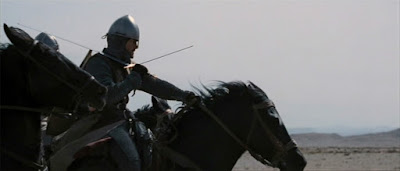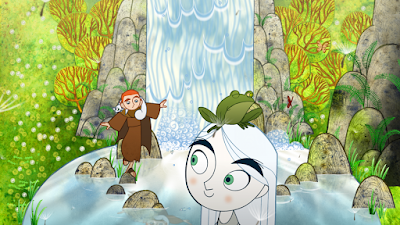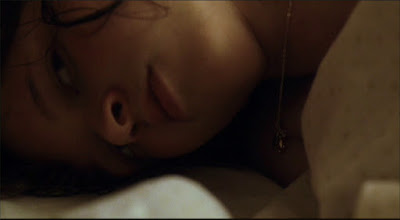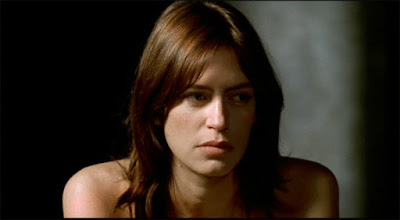
I started this project last year, then promptly let it lay fallow after a couple of entries. I always intended to get back to it, but I didn't expect to take so long. I'm skipping around a little here. Ideally, I should write about Kiss Me Deadly in this slot. I'll come back to Kiss Me Deadly at some point in the future. For now, though, we have The Big Knife from 1955, Robert Aldrich's sixth film.
The Big Knife was made with the same crew that Aldrich used for Kiss Me Deadly, more or less, and it has something of the same look to it. It's a harsh film, and unbeautiful. Aldrich is telling an ugly story about ugly people, so he lets the way he films things speak to this. The 'big knife' of the title is pointed directly at the back of the studio system. Every so often, Hollywood produces a film like this one in a fit of self-loathing; you can shelve this with Sunset Boulevard, Sweet Smell of Success, and The Player. This one isn't quite in the front rank of these kinds of movies, but it does play in the same league. It turned out to be a problematic film for Aldrich, given that Harry Cohn, the notoriously cheap head of Columbia Pictures, saw a little too much of himself in Rod Steiger's monstrous studio head. The character itself is a bit of an amalgam, but at one point, he says "hail Columbia" in another context and that iced it for Cohn. He had Aldrich removed from The Garment Jungle and unofficially blacklisted. Aldrich, for his part, never played games with the studios and never sold out his associates. He gave the studios the finger and then went to Europe to make movies for a while. When he came back, films like What Ever Happened to Baby Jane, Hush, Hush Sweet Charlotte, and The Dirty Dozen were all money-making machines and Hollywood loves money more than it loves its dignity, so all was ultimately forgiven.
It seems odd to say that The Big Knife is one of the first fruits of Aldrich's mature style given that it's completely dominated by its screenplay and actors, but there it is. This is a case of the director finding material that is totally personal to him, but also totally personal to everyone else involved. I wonder how an auteurist would shoe-horn this into the theory. The hallmark's of Aldrich's films are here in spades: the flawed individualist lead character, the oppressive system that destroys him, the overcooked hothouse atmosphere. This is all marked indelibly on the film. But even so, it doesn't exactly feel like an Aldrich movie. I think this disconnect stems from the fact that Aldrich has chosen not to "open" up Clifford Odets's play for the cinema. He confines the action to a limited number of sets and he gives the actors their heads when it comes to chewing the scenery. This isn't movie acting, really. It's some strange hybrid of stage acting and movie acting. As with most of Aldrich's films, the combination of elements steers the whole thing toward the Gothic: you get in this movie a microcosm where the forces of the id do battle.
The story here follows actor Charlie Castle, who is being pressured into signing a long-term contract with Hoff International Pictures, headed by the soft-spoken sociopath, Stanley Hoff. Hoff has leverage over Charlie resulting from a DUI incident that resulted in a fatality at some time in the past and he isn't above using it. Charlie's estranged wife, Marion, doesn't want Charlie to sign and threatens to leave him if he does. Charlie, for his part, doesn't want to sign, either. He's sick of the kinds of artless crowd-pleasers to which another seven years with Hoff will consign him, but his tough-guy image on screen isn't matched in real life by the actor. Charlie is fundamentally weak. Thrown into this mix are the icy Smiley Coy, Hoff's major domo, who insinuates ways of "getting rid" of problems; Connie Bliss, the wife of the fall guy for Charlie's DUI, who is an amoral sexual predator; and Dixie Evans, a dipsomaniac contract starlet who knows too much for her own good and has a habit of blabbing. It's a fine cast of monsters. Odets includes a writer character, Horatio, who remains apart from everything, presumably in the role of Greek chorus, but he's a stand in for the playwright himself. For the time, the behind the scenes shenanigans portrayed in this film were a scandal, from the casual sexual infidelities to the hints of an orgy going on next door to Charlie's house. I imagine that this is probably accurate, in so far as Aldrich and company depict as much as they can get away with under the production code. The real thing was probably very much like this, only more so.
Aldrich made a couple of pictures with Jack Palance, who plays Charlie. This is the sort of role that Kirk Douglas or Burt Lancaster spent the 1950s perfecting and it's surprising that Aldrich didn't make this with Lancaster, who would ultimately make four pictures with the director. Aldrich never liked to restrain his actors and Palance takes everything he can get from the movie and more so. All of the performances here are overcooked, from Steiger's method actor rage--his Stanley Hoff is essentially Godzilla, laying waste to everything in his path--to Jean Hagen's burlesque version of a ruthless slut. The screenplay is an accomplice in this, with ripe lines like "I don't care if I do see a snake. I'm sure I'd much rather see a snake than a Hollywood producer." and, "How dare you come in here and throw this mess of naked pigeons in my face!" This isn't exactly naturalistic filmmaking. A couple of actors actually do dial it back, though, and are conspicuous for it: Ida Lupino's Marion is a steadying influence as the film's niggling conscience, and Wendell Corey is a block of ice as Coy.
As I say, this is a writer's and actor's picture, but there are some interesting stylistic flourishes here and there. This is certainly more tightly controlled than Aldrich's earlier Westerns. Take for instance this shot:

This is interesting for a couple of reasons. For one, it throws out the Wellesian film grammar that indicates powerful characters based on the camera angle. The camera usually looks up at powerful characters, but here the audience is looking up at Charlie, a weak character. For another, it uses a far older visual shorthand to indicate status. Charlie is lower in the frame than his agent, with the positions of the characters acting as a kind of hierarchy. Aldrich repeats this kind of hierarchical blocking here:

And here:

In all of these shots, you're looking at a whipped dog. It's interesting that Charlie has the same cowed attitude to virtue--embodied in Ida Lupino's Marion--as he does with corruption (Hoff).
Later, in the film, Aldrich uses sight lines to indicate power relationships. In the first confrontation between Charlie and Hoff, Charlie looks everywhere but at Hoff, and, pointedly, everywhere but at the camera. His sight lines are twitchy and scattershot:

Charlie Castle is an interesting variation on Aldrich's usual protagonists. His stock anti-heroes are generally tested by their inflexible individualism running afoul of an uncaring system that has no use for individuals. They usually suffer for refusing to compromise their morals. In this case, Charlie suffers because he's all too willing to compromise his morals. There's no moral victory here, as there sometimes is for Aldrich's other anti-heroes. Charlie's moral turpitude is annihilating. In some ways, this is just as nihilistic a movie as Kiss Me Deadly, only without the hugger mugger of a glowing suitcase and an atomic explosion at the end. There's something to be said for that. This can be considered to be film noir, after all, and film noir tends towards the existential. In the words of Sartre: Hell is other people.















































